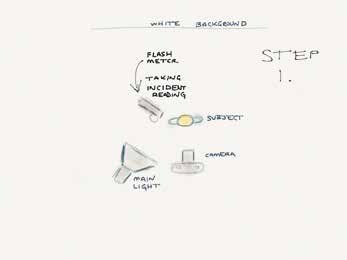articles/Lighting/lmsw-page3
Lighting Masterclass by Stuart Wood - part 3 of 1 2 3
by Stuart Wood Published 01/04/2014

At this point we should all pat ourselves on the back for a job well done. Ok, now we have all done that, there are a few little 'pointers' to bear in mind when using this technique, so that we can get the very best from our nice clean white, because we need to avoid lens flare and we also need to stop our background directly effecting our foreground.
Earlier I mentioned positioning our background well back from our subject. This is because now we have lit our background a full two stops brighter, it will in effect become another light source and if we have our subject too close to it, our subject will also be lit by the light coming from our background causing at times a bright 'glow' around our subject or it may simply cause an edge light on part of our subject (perhaps on the side of a face) that simply is not wanted.
At this stage we all now need a basic understanding of our old friend the 'inverse square law' and how light falls off from it's source. Again 'You Tube' it if you don't know about this as trust me, we will all be much better photographers if we not only understand this law but can use it to our advantage. In this case, we will need to move our subject far enough away to prevent the background from having any effect on our foreground subject.
Because of all the white light that we have just deliberately encouraged to render our background white, some of this could also be now shooting straight down our lens and running the grave risk of producing lens flare on our images. This can effect the colour, contrast and overall sharpness of our image and unless such an 'ethereal' effect is desired, this should be avoided at all costs.
First of all, employ the services of a good lens hood which will immediately cut down some of the unwanted white light flying around.
Then if you can, imagine our background as a large window or mirror. If we now stand where our camera is and if any of our lights that are lighting our background are now being 'reflected' in our large 'window', (ie, were it to be a real window we would actually see the light in it!) this will probably mean that the light from this light source stands a good chance of shooting down the lens and creating unwanted lens flare.
As we know that light travels in straight lines, we need to try and place our background lights at such an angle to our background as to make them light our background properly but then reflect our unwanted light from our background and away from our lens position.
So in effect, we need to 'side light' our background evenly from both sides, so that the reflected light from our studio lights is reflected away from our lens.
Extra detail can be also added to the edges of your subject (anyone who has shot someone in a white dress against a white background will know what I mean!) by using black reflectors around your subject. These will not reflect any light onto the subject and absorb any stray light around the subject giving extra defined edges.
So there we have it!
Like everything else, if you are not well versed in this technique go and test shoot it until you are.
Even if you have a small studio, you can still make this work, as those delegates that attended my recent Advanced Lighting Superclass at the SWPP Convention will testify. I still managed to produce a perfect white background in a small hotel conference room with only two lights. I lit the model with one light and my white background with the other (which was only a conference white board already fixed to the wall) and STILL managed to get a perfect white background, because I followed this simple procedure.
So the next time you come across anyone trying to sell you equipment that you just do not need to get your white background, or you hear the 'false prophets' trying to lead you astray, just remember that immortal and oh so true quote from Star Trek.
"Ye cannae change the laws of physics, Jim"
Please Note:
There is more than one page for this Article.
You are currently on page 3
- Lighting Masterclass by Stuart Wood page 1
- Lighting Masterclass by Stuart Wood page 2
- Lighting Masterclass by Stuart Wood page 3
1st Published 01/04/2014
last update 09/12/2022 14:56:04
More Lighting Articles
There are 0 days to get ready for The Society of Photographers Convention and Trade Show at The Novotel London West, Hammersmith ...
which starts on Wednesday 15th January 2025





